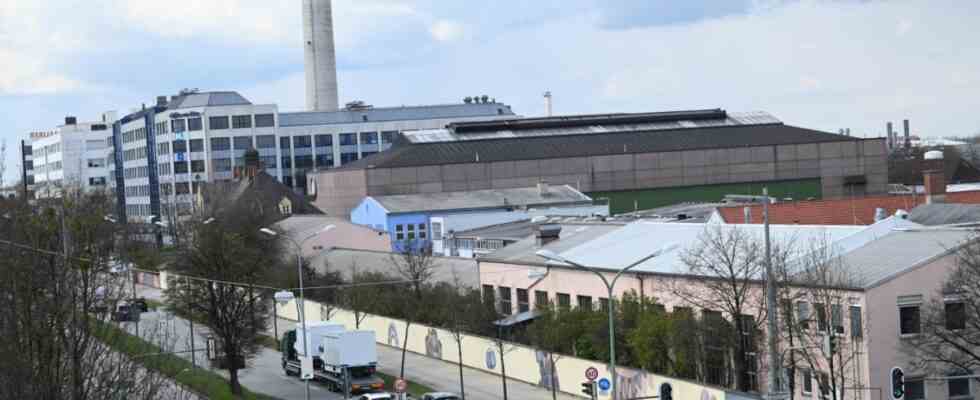Technology companies, start-ups, trade fairs: everyone wants to come to Munich – or stay here. The city has been wondering for years where there is still room for the growing economy. She expects that by 2030 there will be demand for almost 120 hectares of commercial space for new companies or the relocation of existing Munich companies.
In the north of Munich, she has now identified a large area with potential for growth, or rather: potential for change. According to the city’s will, the commercial areas on the Frankfurter Ring are to be converted into so-called “productive city districts” in the coming years. An important building block in the concept is building upwards.
The rough framework for the restructuring of the 167 hectare area has now been discussed in the planning committee of the city council. It lies between the Frankfurter Ring and Moosacher Straße in the south and the DB-Nordring in the north, between the old Knorr- Bremse area in the west and the Autobahn bridge in Freimann known as the “Tatzelwurm”. The area is to be called the “Frankfurter Ring Commercial Band” in the future. The concept envisages that an urban environment of classic trade, commerce, gastronomy and leisure activities will be created there.
New working worlds require new urban worlds
As the world of work changes, a city where many people want to work also has to change. Office towers require a different infrastructure than factory buildings. “The existing, high development pressure that lies on these peripheral, often underused areas should be steered on the basis of a holistic development perspective in a sustainable and coordinated direction in terms of urban development,” says the draft resolution from the Department for Urban Planning and Building Regulations, the has now been submitted to the planning committee for approval.
In concrete terms, this also means that the city sees potential for further high-rise buildings in the commercial zone in the north of Munich. A total of five locations have been identified. The highest height of 100 meters would therefore be possible in the very east of the commercial zone. To the west, the planned height profile drops to 40 meters – also because of the proximity to the Olympic Park.
In a study commissioned by the city, the commercial zone Frankfurter Ring was divided into four zones. In the west – the “Frankfurter Tor” – production and logistics are the main focus. In the “Neue Mitte Milbertshofen” the historic town center and the residential buildings will be preserved and upgraded with a new neighborhood park. According to the concept, a mixture of work, local supply, culture and living is to be established in particular on the former commercial areas between Knorrstrasse and Schleißheimer Strasse.
The IT center of BWM and the new office building “Neue Siederei” are located in the “Business Cluster”. According to the statements, smaller manufacturers could settle on the smaller plots in this zone or spaces for hybrid use could be created. High points with a maximum height of 80 meters would also be conceivable in this area. “Repression not only plays a role in housing, but also in business,” said Simone Burger from the SPD/Volt city council faction. In Munich, high prices per square meter are also being asked in this area, and smaller businesses are often unable to keep up. “A productive city means there are jobs for everyone,” she said.
High-rise buildings 100 meters high are conceivable near the student city
The easternmost part of the industrial strip, entitled “Industrie-Motor”, will later resemble the Werksviertel at the Ostbahnhof. The Freimann power plant of the Stadtwerke is still here today, and it is to be preserved. The zone borders on the A9 motorway exit to Berlin, the Domagkpark and the Euro-Industriepark and is therefore in an area where a number of construction projects are pending. According to the study, the industrial motor zone is particularly well suited to setting an architectural sign at the entrance to the city.
So-called “city signs” with the Munich upper limit of 100 meters would even be conceivable at the Europark S-Bahn station and in the vicinity of the Studentenstadt. However, there are divided opinions in the planning committee. “The city sign is directly in line of sight from Odeonsplatz across Leopoldstrasse,” said Brigitte Wolf (left). However, she sees no need for further high points here. “That was screwed up before.” Alexander Reissl (CSU) contradicted this view: “You can also see from the inner city when you look outside that there is another outer city.”
The majority of the members of the planning committee did not like the fact that the pressure on the housing market plays at most a subordinate role in the proposal for the commercial volume, which is why a decision was postponed to the general assembly of the city council. “We should investigate whether more housing is possible. Maybe also with special forms such as trainee housing or flexible housing if regular housing is difficult because of the noise,” said Paul Bickelbacher (Greens).

